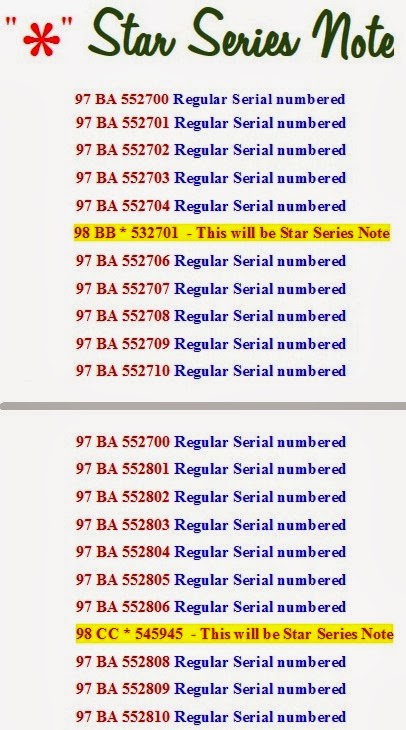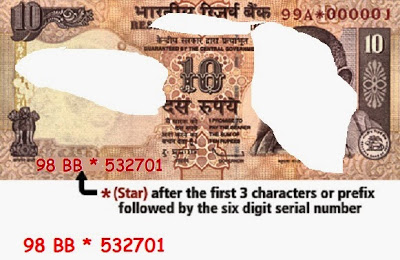Star Series Bank Notes
Some interesting information on Bank Notes:-
The bank notes issued by the Reserve Bank of India are in packets of 100s. The earlier practice of stapling the 100 note packs – carried out since introduction of the Bank Notes – have been discarded two decades ago as they cannot be used for dispensing the notes by ATM. Also the life of the stapled notes were far less than the non stapled notes. Similarly one more deviation in the usual practice was introduced by RBI by introducing Star Series Notes.
The Bank Note production process is complicated and involves several procedures and steps. One of the standard practices followed universally is to issue the bank notes in bundles of 100 notes, each 100 notes placed in sequential serial order beginning from one particular no. During the production process especially during numbering process, as is normal in any other printing process, some sheets get printed with some unforeseen, unavoidable printing errors called ‘numbering defects’ thus disturbing the continuity and therefore they have to be replaced.
The Process, Paper and Inks used for Bank Note Printing being costly, the entire defective sheet containing defective/ wrong numbers in one or two notes in whole sheet cannot be expected to be destroyed totally. Moreover in order to simply replace few defectively numbered notes the entire process cannot be redone to get correct serial numbered note because the process is time consuming and also involve additional cost. This is not the case in India alone but is universally faced phenomenon.
Therefore in order to reduce the cost a new practice was introduced to issue specially numbered notes called ‘Star Series’ which will not have sequentially numbered serials in a bundle of 100 notes. Such Star Series notes were inserted replacing the defective notes in the bundles containing 100 nos of serialized notes. The Star Series note bundles though will contain 100 notes per packet may not have sequential serial beginning from a particular number and may contain one or two Star Series numbered note s in between.
The Star Series Notes will be printed with a special mark like a Star symbol in suitable place in the numbering panel to identify that the 100 note packet is Star Series numbered notes. Since no two serial numbers can remain the same, the note is simply printed with a Star mark symbol in the serial number panel, identifying it as a replacement for an error notes.
For example in a bundle of 100 notes, there may be few wrongly numbered notes, say, from 97 BA 552701 to 97 BA 552710 one note may have been wrongly numbered and need to be replaced. The replaced note will be something like the one illustrated below:
The Bank Notes issued by RBI prior to 2006 were in sequential number. No bundle had discontinued serial number. In this process whenever the notes were seen to contain wrong numbers they were separately printed and inserted in the bundles of 100 notes replacing the defective numbered notes. This process was time consuming, involved several avoidable and repeated process cycle in addition to increase the cost of printing.
However as the said process continued over the years, keeping pace with international best practices, in India too the Reserve Bank too commenced issue of ‘star’ series of bank notes from 2006 in various denominations like Rs 10, Rs 20 and Rs 50. RBI adopted Star Series numbering system for replacement of defectively printed banknotes.
The Star series banknotes were exactly similar to the existing Mahatma Gandhi Series banknotes, but with an additional character say a star symbol like * in the number panel in the space between the prefix (Two Alphabets printed followed by numerals) and the serial number. The 100 note packets containing those bank notes will not have sequential serial numbers, but contain 100 banknotes, as usual. To facilitate easy identification of the bundles that carry star series notes, the paper bands that are fastened on 100 notes bundle carried captions like ”contains non serially numbered notes” .
Some of the other countries that introduced star series notes were the following:
- The United States and Australia used “*” in the serial number to mark a replacement banknote. .
- Argentina uses “R” in the serial number to mark replacement banknotes.
- The Bahamas use “Z” in the serial number to mark replacement banknotes.
- Hong Kong and Mongolia use “ZZ” in the serial number to mark replacement banknotes.
- Singapore uses “Z/1” in the serial number to mark replacement banknotes.
- Indonesia uses “X” in the serial number to mark replacement banknotes.
- Zambia uses “X3” in the serial number to mark replacement polymer banknotes.
- Thailand uses “5 OS” in the serial number to mark replacement polymer banknotes.
















Recent Comments